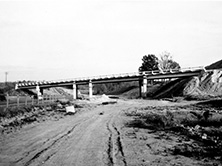 Construction of first bridge over I-85 between Efland and Greensboro, ca.1957 (Courtesy of The State Archives of North Carolina) North Carolina used the same type of bridges—standardized steel stringer, reinforced-concrete tee-beam, and prestressed-concrete stringer—on its interstate highways as it did on other classifications of roads. The bridges on interstate highways, however, are components in a large-scale, highly standardized, highway system. They are designed to facilitate limited access, eliminate all grade crossings, and keep traffic moving at interchanges, in addition to their more common role of carrying traffic over streams, railroads, and other features.
Construction of first bridge over I-85 between Efland and Greensboro, ca.1957 (Courtesy of The State Archives of North Carolina) North Carolina used the same type of bridges—standardized steel stringer, reinforced-concrete tee-beam, and prestressed-concrete stringer—on its interstate highways as it did on other classifications of roads. The bridges on interstate highways, however, are components in a large-scale, highly standardized, highway system. They are designed to facilitate limited access, eliminate all grade crossings, and keep traffic moving at interchanges, in addition to their more common role of carrying traffic over streams, railroads, and other features.
Bridges on interstate highways reflected balanced design for safe, high-speed travel, meaning that every element of the highway, including curves, sight distances, grades, and roadway geometry, was determined by speed so that drivers could easily anticipate road conditions and not encounter surprises. This meant that interstate highway bridges were generally designed to fit the alignment and profile of the highway rather than fitting the highway to the alignment of the bridge. The latter had been the practice in earlier days where bridges often met streams at right angles in order to achieve the shortest crossing. This change in approach from the shortest economical crossing to a balanced design that fit the bridge to the standards and design speed of the highway had a significant impact on bridges, especially those on interstate highways, built by the State Highway Commission during the 1950s. Despite complications created by a greater variety of angled (skewed) crossings and super-elevations (a difference in the height of the inside and outside edges of the roadway to accommodate the speed of traffic), state engineers managed to fit the spans so seamlessly with the highway that, except for railings, motorists had no idea they had crossed a bridge.